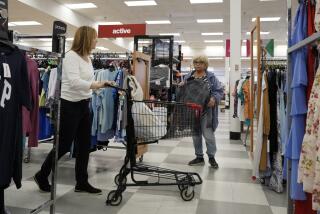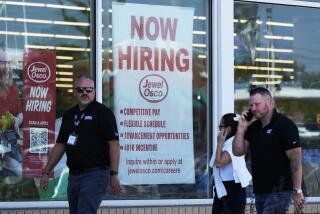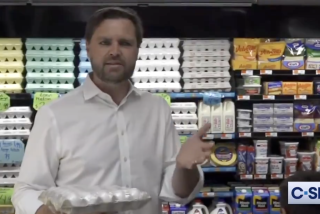Fed Putting a Crimp on Economy, Critics Say
- Share via
WASHINGTON — Unemployment is at a 23-year low. Inflation is nowhere to be seen. To most analysts, the nation’s economy is doing so well that it is difficult to imagine how to improve it.
“It doesn’t get any better than this,” says Robert G. Dederick, an economist at Northern Trust Co.
Now comes a group of economists who contend that not only can it get better than this but that it should--and that it would if only Alan Greenspan, chairman of the Federal Reserve Board, would loosen up and let interest rates come down.
These “growth optimists,” as they are known, say the Fed’s insistence that the economy cannot grow faster than 2.3% a year without reviving inflation is dead wrong--and is costing output and jobs.
“We think it can grow faster without exacerbating inflation,” said Jeff Faux, executive director of the liberal Economic Policy Institute in Washington and a key proponent of the growth optimists’ point of view.
“How much faster is anybody’s guess,” Faux said, “but we probably can sustain a growth of 3% to 3 1/2%. The problem is, we have a Fed that’s more concerned about making investors comfortable than about growth.”
If the growth optimists are right, the difference is a lot greater than it sounds.
Barry Bluestone, a University of Massachusetts economist, estimates that boosting the growth rate even to 3% would add an average of $300 billion a year to the nation’s output over the next 10 years--raising income, jobs and tax revenues to boot.
Setting a 2.3% speed limit, as the Fed and the White House effectively have done, is unnecessarily depriving the nation of all that, Bluestone writes in the American Prospect, a liberal journal.
“The bridge to the 21st century apparently is being built without a high-speed lane,” Bluestone said.
Liberals are not alone in arguing that the economy can grow more rapidly without reigniting the fires of inflation.
During the 1996 presidential campaign, GOP nominee Bob Dole and his running mate, Jack Kemp, contended that the economy could safely grow faster. Kemp asserted that even 5% might be manageable.
However, the two sides have far different prescriptions for how to spur greater growth. The liberals want to cut interest rates, while conservatives would slash taxes and government regulations.
The view at the Fed is that allowing the economy to grow much faster would risk reviving inflation, which they say is by far the biggest threat to long-term prosperity.
In this view, labor is already scarce in many areas of the country, setting the stage for escalating wages. Higher wages eventually will spawn big price hikes. The wage-price spiral will begin.
Faux and other growth optimists call that line of reasoning out of date and badly flawed. To begin with, they argue, the labor force has excess capacity--in the form of a large, untapped pool of workers who can fill new jobs without straining the system.
They say young men who once dropped out of the labor force are beginning to come back as job opportunities improve. The influx of women into the job market is accelerating again. And older workers are retiring later.
Second, they argue, the advent of new technology, made possible largely by the introduction of the microprocessor, has laid the base for a massive improvement in worker efficiency, a key to faster growth.
Although the change has not shown up in government statistics yet, Bluestone contends that it will as soon as workers and managers learn to use computers effectively.
“There is good reason to believe that we are on the verge of a productivity renaissance,” he wrote, along with Bennett Harrison of the New School of Social Research, in the American Prospect article.
The prospect of a faster-growing labor force and a more rapid increase in productivity ought to make the economy better able to tolerate faster growth without reviving inflationary pressures, the growth optimists say.
Mainstream economic analysts remain skeptical.
Barry P. Bosworth, a Brookings Institution economist, contends that the growth optimists have been proved wrong before. He recalls that critics complained for years that government statistical techniques understated gains in worker productivity. But when measurement techniques were revised, productivity did not improve.
Moreover, Bosworth and other economists argue that even if labor markets turn out not to be as tight as they seem, it would only take a year before the “excess” workers were absorbed and the shortages began.
As a result, he contends, any faster growth would have “a one-shot effect. You’d get to a lower unemployment rate for a while, but that would be it, and then you’d be back to what everyone is talking about now.”
Besides the Fed and most mainstream economists, the Clinton administration and the Congressional Budget Office are backing the view that the optimum economic growth rate is between 2% and 2.5%.
What is ironic to some analysts is that for all of Greenspan’s warnings about overheating, there is little real evidence that the Fed has been excessive recently in restraining the economy’s growth.
Although the Fed did tighten credit in March by boosting the interest rate that banks charge on overnight loans to other banks, the increase was only a quarter of a percentage point, hardly enough to impede growth very seriously.
If anything, monetary analysts point out, the Fed’s rate hike actually reduced interest rates on long-term investments by dampening fears that inflation might be about to rebound.
The Fed has already watched without taking action as the unemployment rate slipped far below the level economists have said would reignite inflation. That level, 6% in the late 1970s and 5.5% in the 1990s, is 5.3% today--still far above the 4.8% jobless rate registered in July.
And whatever Greenspan’s misgivings in March, he has spent much of the summer raising the possibility that the economy has undergone enough basic changes that faster growth may be possible.
At the last two meetings of the Fed’s policy-setting Federal Open Market Committee, Greenspan has been the dove, beating back attempts by more hawkish members to raise interest rates again.
Rep. Barney Frank (D-Mass.), a proponent of faster growth who has criticized Greenspan recently, muses wryly that the chairman has moved considerably toward the liberals’ view. He said that if he had known earlier what he now knows about Greenspan’s position, he might not have been so hard on the Fed chairman.
That leaves the dispute largely a matter of timing. The growth optimists want to let the economy grow faster until signs of renewed inflation begin to show up, while mainstream economists want to keep growth slow until there is evidence that productivity has improved.
To the mainstream economists, the costs of beating back inflation once it begins are far greater than the growth sacrificed upfront to prevent inflation from resuming.
When the Greenspan-led Fed miscalculated in favor of faster growth in 1988, Bosworth said, it found itself unable to cope easily with mounting wage demands and an oil price hike. As a result, the Fed tightened monetary policy sharply, triggering a recession in 1990 that cost many more jobs than slowing the growth rate earlier would have.
For that reason, Bosworth argues, it is important for the Fed to err on the side of caution. The odds are that the central bank will keep watching the unemployment rate edge down without raising interest rates again.
But it is unlikely to do so at a pace that satisfies the growth optimists; what they want is not even on the Fed’s agenda. Faux said: “I think the Fed ought to be lowering interest rates.”
More to Read
Inside the business of entertainment
The Wide Shot brings you news, analysis and insights on everything from streaming wars to production — and what it all means for the future.
You may occasionally receive promotional content from the Los Angeles Times.










